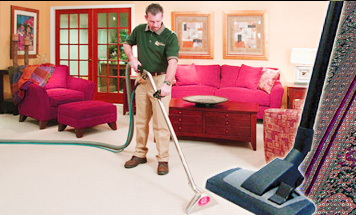|
|
|
|
|
|
| Cleaning Tips |
|---|
Today's carpets are designed to hide soil and even repel it, thanks to advances in
chemical treatments. However, carpet fibers can still trap and hide dust, dirt, bacteria
and other pollutants. Over time, that can lead to matting and a general deterioration of
your carpet.
Regular Carpet Cleaning has a number of benefits that we sometimes forget:
- Divide the facility's floor plan into three categories: high traffic, requiring more frequent and intensive maintenance procedures, and usually daily vacuuming; medium traffic, requiring vacuuming every other day; and low traffic, requiring biweekly vacuuming.
- Use a vacuum cleaner with at least 80 cfm (cubic feet of air per minute) suction power so abrasive grit is removed. For best results, consider a dual-motor, upright vacuum with beater bar or double row of brushes with high suction.
- Slow, deliberate passes with the vacuum cleaner are more effective than quick strokes to remove soil. Make at least four passes forward and backward over the same area.
Spot maintenance
- For dry spills, vacuum the excess material or scrape dried soil with the blunt edge of a spoon. Always work from the outer edge of the spot toward the center.
- For wet spills, extract the material and scrape up the excess.
- Wet the spot with cold water and blot it. Spills caused by a hot substance such as coffee should be removed with water the same temperature as the spilled material after attempting to remove it with cold water. Always blot by pressing downward. Never rub in a circular motion; this can spread the stain. Blot with a white, cotton towel or suction block (a pad specially designed for blotting wet stains) so the color of the spot can be seen on the towel or block as it comes out of the carpet.
- Continue pressing down as spots penetrate toward the carpet backing. Lift the towel or suction block periodically to remove moisture. If the water-cleaning method doesn't work, use cleaning products recommended by the carpet manufacturer.
- When using cleaning products, blot the area with a suction block to remove all chemical residue. Follow with a water rinse to fully flush the residue. Repeat the blotting to dry the carpet.
- After lifting as much of the spot as possible, place a stack of clean, white towels over it. Place a weight on the towels overnight so they press firmly against the spot. This helps remove deeply penetrated residue that may move toward the carpet pile.
Hot water extraction
If new carpet begins to look "tired," hot water extraction can effectively remove dirt and restore new carpet appearance.
- Use a manufacturer-recommended cleaning solution according to instructions. Do not over mix the solution. Using too much hot water extraction solution can leave solution residue in the carpet that can quickly attract and hold soil.
- Extract high-traffic areas every 12 weeks, medium-traffic areas every six months and low-traffic areas annually. Extraction times can be extended if regular cleaning is maintained.
- Thoroughly vacuum traffic areas. Pre-spray a hot water extraction chemical with an airless sprayer. Allow at least five minutes dwell time. Heavily soiled areas may have to be scrubbed with a nylon brush or a rotary machine to break up soil deposits prior to hot water extraction.
- Extract thoroughly, using water only. Do not put any chemicals into the extractor tank. Follow each wet pass with at least three dry passes.
- Enhance drying time by running a dry cotton pad on a low-speed rotary machine. This procedure also will help remove soil left behind during extraction.
- Use small fans or air movers to dry the carpet. Allow three hours of drying time after final extraction before allowing traffic on the carpet.
- When extracting carpet tile, some moisture may ease through the joints. It is essential not to over wet the carpet and to extract as much moisture as possible with the dry passes. Occasionally a tile may loosen if the adhesive gets wet. When the adhesive dries, the tile can be re-adhered to the floor.
|
|
|
|
|
|
|
| All rights reserved. © 2005 - 2008 NJ CARPET CLEANING |
 nj-carpet-cleaning.com
nj-carpet-cleaning.com About Us
About Us Services
Services Free Estimate
Free Estimate Local Cleaners
Local Cleaners Cleaning Tips
Cleaning Tips Coupons
Coupons Recommended Sites
Recommended Sites
 Home
Home
